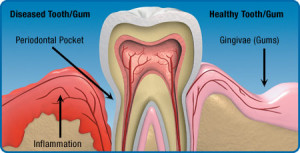 At the new patient exam, your dentist will do full mouth gum pocket as well as recession measurements, carefully examine the gums for signs of bleeding, infection, tissue and bone health. An individualized hygiene plan is then designed. This may include cleaning, scaling and planing by our hygienists all the way to referrals to periodontists who specialize in the care, maintenance and treatment of gum health.
At the new patient exam, your dentist will do full mouth gum pocket as well as recession measurements, carefully examine the gums for signs of bleeding, infection, tissue and bone health. An individualized hygiene plan is then designed. This may include cleaning, scaling and planing by our hygienists all the way to referrals to periodontists who specialize in the care, maintenance and treatment of gum health.
Up to 80% of the population unknowingly has some form of gum disease or “peridontal disease.” It starts with gingivitis, a chronic inflammation of the gum tissue, and this may have little or no discomfort and few symptoms in the early stages.
When peridontal disease is not treated it can spread and severly compromise the gums and bone holding the teeth. Once bone is lost it cannot generally be regrown and in extreme cases leads to tooth loss. Gum disease has also been linked to heart disease, strokes, bacterial infections and can complicate other chronic conditions.
Smoking, stress, some medications, brushing or teeth grinding, diabetes, poor nutrition, HIV, heredity and poor oral hygiene are all factors that alone or together can greatly exacerbate peridontal disease. Gums irritated by bacteria in the mouth can recede away from the root surfaces of the teeth, creating deep pockets where more bacteria can hide and flourish.
TREATING PERIDONTAL DISEASE
 Early on, when redness, swelling and bleeding are the only symptoms, we can treat and reverse gum disease. This is what our hygienists do when they scale, root plane, polish the teeth and educate how to keep one’s teeth clean.
Early on, when redness, swelling and bleeding are the only symptoms, we can treat and reverse gum disease. This is what our hygienists do when they scale, root plane, polish the teeth and educate how to keep one’s teeth clean.
Regular check ups greatly increase the likelihood of early detection, resulting in a much more conservative treatment. The patient’s home oral hygiene routine is a large factor in containing gum disease. That along with professional removal of plaque and tartar from all tooth surfaces are key to long term dental health.
SPECIALIST REFERRALS
If gum disease becomes advance, or does not respond well to conventional treatment, surgery may be needed to control the disease. In that case we would refer you to a periodontist (gum specialist) who may perform surgical treatments such as pocket reduction, bone or tissue regeneration, gum grafting and esthetic gum replacement procedures. These may be performed on one specific are of the mouth or throughout.